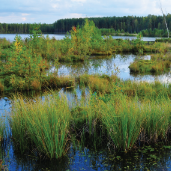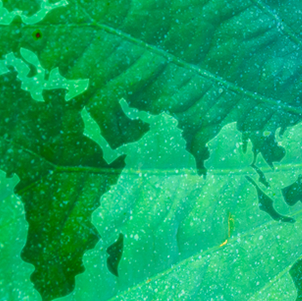
Nature-inspired buzz added hopeful twist to climate change conference
The next frontier is to capture and use the excess carbon that already exists in our economy and in our atmosphere.
Read More
The next frontier is to capture and use the excess carbon that already exists in our economy and in our atmosphere.
Read More
Enter biomimicry, and a set of solutions that looks to nature for strategies to manage carbon.
Read MoreWe are always excited to share inspirations from nature—biomimicry, after all, is innovation inspired by nature. We’re extra excited to share this new video that takes you to South Africa and offers a glimpse into our biomimicry immersion workshop experience. Shot last November during our Discovering Nature’s Genius workshop in Leshiba Wilderness, Limpopo province, South Africa, the video is a beautiful, exciting snapshot of the experiences people have while exploring biomimicry in the field. Biomimicry 3.8 has been putting on workshops since 2002. We’re planning to host several more in 2016. Feeling inspired? Our next workshop will take participants to the Netherlands for the first European-based Biomimicry Thinking for Social Innovation workshop. The workshop will explore the fusion between biomimicry and social innovation—inviting participants to re-imagine organizational leadership, strategy, planning, and operations with inspiration from healthy and evolving ecosystems. The workshop will be taught by our own Dayna Baumeister and Toby Herzlich, founder of Biomimicry for Social Innovation. The six-day experience...Read More >
Read MoreWhen in comes to bringing biomimicry to the built environment, what are three approaches architects should consider? What are the best practices when it comes to adding biomimicry to the design process? Biomimicry 3.8’s Jamie Dwyer will detail and discuss three benefits of bringing biomimicry to the built environment during Verdical Group’s free Biomimicry 2016: The Road to Resiliency conference on Friday, March 11. The panel, “Scale and Best Practices for Architects” will include Chris Garvin, Managing Partner for Terrapin Bright Green. The conference takes place in Irwindale, California, from 8 a.m. to 1 p.m. Space is still available; register here. Jamie is a Biomimicry 3.8 principal who has fused architecture and biology degrees into a career as a biologist at the design table. She’s worked on dozens of projects that have incorporated biomimicry—some of which she’ll discuss during the panel—throughout the years. What would she tell other designers anxious to incorporate biomimicry into their design work? For one, biomimicry...Read More >
Read MoreIf we compress the age of Earth (4.5 billion years) into one year, Thursday, February 25, would be the day life appears. That means it was 3.8 billion years ago this week that the first single-celled organism appeared. Since then, Life has been the ultimate innovator, creating conditions that are conducive, to well, Life. Consider this: Homo sapiens sapiens (that’s us) have been on Earth for about 200,000 years. That’s the equivalent of less than 30 minutes of Earth’s Calendar Year, with humans appearing on the scene on December 31 at 23:26! With 3.8 billion years to celebrate, we think Life has earned the title of wise. Biomimicry is based on the premise that we aren’t the only species who calls Earth home. It’s a practice that recognizes the clues to our path forward can be found in wisdom compiled during the last 3.8 billion years. That’s why we celebrate Life’s Birthday. To remember that Life is so much bigger...Read More >
Read MoreOf the thousands of biomimicry-inspired innovations budding throughout the world each day, a large number don’t include collaboration with a biologist. Emilie Snell-Rood pointed to this stat—fewer than 8% of the nearly 300 studies on biomimetics published in the past 3 months and indexed in the Thomson Reuters Web of Science had an author working in a biology department—in a compelling article for Nature where she argues that embracing teamwork and bringing biologists of all kinds to the collaborate on biomimicry-based projects is necessary for continued, meaningful advancement of innovation. She writes: With around 1.5 million described species, and probably some 9 million eukaryotic species in existence, researchers pursuing biomimetic approaches have barely scratched the surface of biological inspiration. Biologists from all sorts of disciplines have an extraordinary store of knowledge that could guide forays into a much richer diversity of natural systems. Such knowledge could also help to steer experimental approaches. Biomimicry 3.8 co-founder Dr. Dayna Baumeister agrees, of course. In fact,...Read More >
Read MoreBiomimicry 3.8 co-founder Janine Benyus will join Project Drawdown founder Paul Hawken in conversation this week at Buildwell 2016, a two-day conference for people who are inventing a healthy, low-carbon 21st century architecture. Benyus will speak Feb. 10, highlighting the role nature’s genius can play in creating building materials and built environments that not only help eliminate and draw down carbon emissions, but provide net-positive impact. “In the past, we’ve asked (buildings) to reduce energy use, reduce how many toxins are used in building materials—to reduce impacts,” Benyus said. “In the future, I think we’ll be asking them to filter their own water, to purify air around them, and send the air downwind cleaner than it came. I think we’ll be asking them to squeeze carbon into their site using the building materials themselves.” This is something nature does every day. Native landscapes provide ecosystem services—like trapping carbon, purifying water and supporting biodiversity—that clean the air, replenish water supplies, and...Read More >
Read MoreBone Structure image via Shutterstock The Airbus Group is taking innovation inspired by nature to the air by using 3D printing to help build a stronger, lighter-weight galley partition that mimics cells structure and bone growth. The design literally lightens each airplane’s load, allowing it to do things like save a projected 465,000 metric tonnes of CO2 emissions per year. According to Airbus, “this makes the bionic partition a groundbreaking development for a sector in which less weight equals less fuel consumption” (read more about how Airbus learns from nature here.) In this edition of Innovation Inspirations, we’ll take a look at the biology of bones, and explore what else nature can teach us about creating life-friendly materials that are lightweight and super-strong. Why bones should be industrial designers’ best friend: In nature, bones grow in response to mechanical stress and loading. Bones need to be strong, yet lightweight. Bone is made of a composite material that is about 95%...Read More >
Read MoreGreenBiz16 will gather a set of visionaries, gurus, and business leaders near Phoenix, Arizona, February 23-25, to define the greatest trends, challenges and opportunities in sustainable business today. The annual conference is a forum to discuss big (sustainability) ideas in the world of big business. But what can nature teach us about running a thriving, sustainability-driven business? Thanks to 3.8 billion years of evolutionary R&D, nature has much to teach us about sustainable business practices. We’re excited to bring biomimicry to GreenBiz once again, and are cooking up several opportunities for attendees to learn more about the practice’s application to sustainable business and leadership practices. First off, Biomimicry 3.8 co-founder Dayna Baumeister will present “Systems Thinking: Nature inspired business lessons” on the event’s main stage at 10:55 a.m. on Thursday, February, 25, where she’ll highlight nature’s key insights that can increase a company’s resilience, drive innovation, and help regenerate our culture, economy, and planet. Dayna will also host a Greenbiz...Read More >
Read MoreThe Ellen MacArthur Foundation, in partnership with World Economic Forum and McKinsey and Company, released a new report today that defines a vision of a world where plastics never become waste. “The New Plastic Economy” is a visionary report that defines a plan to empower plastic in a sense, by using circular economy principles. Applying circular economy principles to global plastic packaging flows could transform the plastics economy and drastically reduce negative externalities such as leakage into oceans, according to a press release about the report. We are proud affiliates for the foundation’s CE100 program, and are excited to support such a wonderful vision that finds new ways to envision plastic packaging to help protect what nature’s genius has created on Earth. After all, nature is the original circular economy. Biomimicry-based innovations eliminate waste by designing for optimal use of resources and eliminating redundancies. Download the full New Plastic Economy report Why focus on plastic? The report lays out a set of astounding...Read More >
Read More